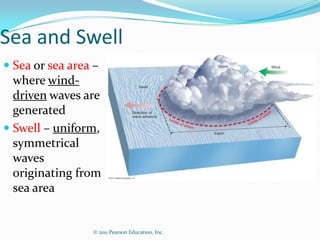
Waves - Swell, Types, Reflection, Refraction, Tsunamis
- 1. Sea and Swell Sea or sea area – where wind- driven waves are generated Swell – uniform, symmetrical waves originating from sea area © 2011 Pearson Education, Inc.
- 2. Factors Affecting Wave Energy Wind speed Wind duration Fetch – distance over which wind blows © 2011 Pearson Education, Inc.
- 3. Wave Height Directly related to wave energy Wave heights usually less than 2 meters (6.6 feet) Breakers called whitecaps form when wave reaches critical steepness Beaufort Wind Scale describes appearance of sea surface © 2011 Pearson Education, Inc.
- 4. Global Wave Heights © 2011 Pearson Education, Inc.
- 5. Beaufort Wind Scale © 2011 Pearson Education, Inc.
- 6. Maximum Wave Height USS Ramapo (1933): 152-meters (500 feet) long ship caught in Pacific typhoon Waves 34 meters (112 feet) high © 2011 Pearson Education, Inc.
- 7. Wave Energy Fully developed sea Maximum wave height, wavelength for particular fetch, speed, and duration of winds at equilibrium conditions Swell Uniform, symmetrical waves that travel outward from storm area Long crests Transport energy long distances © 2011 Pearson Education, Inc.
- 8. Swells Longer wavelength waves travel faster and outdistance other waves Wave train – a group of waves with similar characteristics Wave dispersion – sorting of waves by wavelengths Wave train speed is ½ speed of individual wave © 2011 Pearson Education, Inc.
- 9. Wave Train Movement © 2011 Pearson Education, Inc.
- 10. Waves in Surf Zone Surf zone – zone of breaking waves near shore Shoaling water – water becoming gradually more shallow When deep water waves encounter shoaling water less than ½ their wavelength, they become transitional waves. © 2011 Pearson Education, Inc.
- 11. Waves Approaching Shore As a deep-water wave becomes a shallow-water wave: Wave speed decreases Wavelength decreases Wave height increases Wave steepness (height/wavelength) increases When steepness > 1/7, wave breaks © 2011 Pearson Education, Inc.
- 12. Waves Approaching Shore © 2011 Pearson Education, Inc.
- 13. Three Types of Breakers Spilling Plunging Surging © 2011 Pearson Education, Inc.
- 14. Spilling Breakers Gently sloping sea floor Wave energy expended over longer distance Water slides down front slope of wave © 2011 Pearson Education, Inc.
- 15. Plunging Breakers Moderately steep sea floor Wave energy expended over shorter distance Best for board surfers Curling wave crest © 2011 Pearson Education, Inc.
- 16. Surging Breakers Steepest sea floor Energy spread over shortest distance Best for body surfing Waves break on the shore © 2011 Pearson Education, Inc.
- 17. Surfing Like riding a gravity-operated water sled Balance of gravity and buoyancy Skilled surfers position board on wave front Can achieve speeds up to 40 km/hour (25 miles/hour) © 2011 Pearson Education, Inc.
- 18. Wave Refraction Waves rarely approach shore at a perfect 90 degree angle. As waves approach shore, they bend so wave crests are nearly parallel to shore. © 2011 Pearson Education, Inc.
- 19. Wave Refraction © 2011 Pearson Education, Inc.
- 20. Wave Refraction Gradually erodes headlands Sediment accumulates in bays © 2011 Pearson Education, Inc.
- 21. Wave Reflection Waves and wave energy bounced back from barrier Reflected wave can interfere with next incoming wave With constructive interference, can create dangerous plunging breakers © 2011 Pearson Education, Inc.
- 22. Standing Waves Two waves with same wavelength moving in opposite directions Water particles move vertically and horizontally Water sloshes back and forth © 2011 Pearson Education, Inc.
- 23. Tsunami Seismic sea waves Originate from sudden sea floor topography changes Earthquakes – most common cause Underwater landslides Underwater volcano collapse Underwater volcanic eruption Meteorite impact – splash waves © 2011 Pearson Education, Inc.
- 24. Tsunami Characteristics Long wavelengths (> 200 km or 125 miles) Behaves as a shallow-water wave © 2011 Pearson Education, Inc.
- 25. Tsunami © 2011 Pearson Education, Inc.
- 26. Tsunami Destruction Sea level can rise up to 40 meters (131 feet) when a tsunami reaches shore. © 2011 Pearson Education, Inc.
- 27. Tsunami Most occur in Pacific Ocean More earthquakes and volcanic eruptions Damaging to coastal areas Loss of human lives © 2011 Pearson Education, Inc.
- 28. Historical Tsunami Krakatau – 1883 Indonesian volcanic eruption Scotch Cap, Alaska/Hilo, Hawaii – 1946 Magnitude 7.3 earthquake in Aleutian Trench Papua New Guinea – 1998 Pacific Ring of Fire magnitude 7.1 earthquake Indian Ocean – 2004 Magnitude 9.3 earthquake off coast of Sumatra Japan – 2011 Magnitude 9.0 earthquake off coast of Japan © 2011 Pearson Education, Inc.
- 29. Historical LargeTsunami © 2011 Pearson Education, Inc.
- 43. Banda Aceh Before Flooding Imagery collected June 23, 2004
- 44. Banda Aceh Flooding Imagery collected December 28, 2004
- 45. Tsunami Satellite Picture - Before & After - Banda Aceh Shore
- 46. Banda Aceh Grand Mosque (Before Tsunami) Imagery collected June 23, 2004
- 47. Banda Aceh Grand Mosque Imagery collected December 28, 2004
- 48. Banda Aceh Detail Before Debris Imagery collected June 23, 2004
- 49. Banda Aceh Debris Detail Imagery collected December 28, 2004
- 50. March 11, 2011
